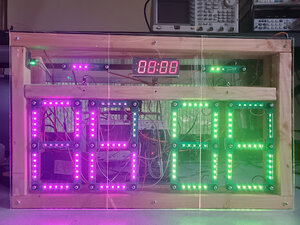
College of Engineering Unit:
The Tailgater Scoreboard is a wireless LED scoreboard that can keep track of several games like cornhole and basketball. The functions include large score displays, win counters for tournament-style games, and an onboard timer. It is controlled using a wireless remote that can change the score and customize the board for each team. The board also has a versatile mounting system that allows the players to stand it up on a flat surface or mount it on a wall.
The scoreboard consists of four seven-segment displays, two for each team, that can be customized with various colors and brightnesses. These displays were custom-made by the team using Neopixels and student-designed PCBs. It also has an onboard timer and circuitry to read and display how much battery is left in the system. All communication is completely wireless using an IR remote and several IR diodes mounted throughout the system. All code is ran on an ESP32.
This project had several challenges that the team had to overcome. For starters, the system contains nearly 150 onboard LEDs, not including the timer circuitry. All of these LEDs draw a lot of power, so the team had to design a power system that can safely support all of these components while also allowing it to be battery-powered for at least an hour. Furthermore, the enclosure was a unique challenge for the team. All members of the team are ECE majors and, since the system was too large to 3D print, an enclosure had to be made using a range of new skills. To create the enclosure, the team built a wooden frame and had acrylic faceplates laser cut to fit all of the components. Not only does the enclosure fit all of the components, but it also is strong and light enough to mount the system on a wall using the onboard mounting hardware. Finally, a large concern throughout the project was making sure that no outputs were interrupted and that they are all displayed accurately. To accomplish this, steps were taken to ensure that all of the code was quick and non-linear so that each function had time to complete before new inputs were introduced. This was done by carefully using interrupts and debouncing all signals to give other outputs time to finish. By working together, the team was able to face these challenges head-on and create a product they are really proud of.
Project Website(s):
Industry Sponsor(s):